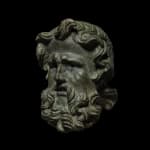-
Artworks
Hellenistic male head, circa 2nd-1st century B.C.
Bronze5 x 3 3/4 x 4 3/4 in
12.7 x 9.5 x 12 cmFurther images
Head of a bearded male, probably a triton, though possibly another ‘wild man’ such as a giant or centaur. His thick curling hair has a pronounced forelock, and his long...Head of a bearded male, probably a triton, though possibly another ‘wild man’ such as a giant or centaur. His thick curling hair has a pronounced forelock, and his long beard falls in tousled ringlets. The expressive face is amplified by a deeply furrowed brow and thick lips. The eyes and bared teeth are inlaid with silver, the mouth is open and hollow, and the pupils are hollowed out. Intact, presence of cuprite and malachite crystals, traces of retouching to the patina.
Of a particularly high quality, this head was cast as a single piece and attached to a figure, or was used as an element in a larger decorative schema. Triton was the son of Poseidon and the sea-nymph Amphitrite. He was a sea god, with the head and torso of a man and the tail of a fish, or often a pair of spiralling fish tails.Provenance
Paul Angoulvent (1899-1976), France; acquired prior to 1956, inventory number B4, previously mounted on a 19th century giallo antico base. Angoulvent was the former director of the Chalcographie du Louvre, founder then President of the Presses Universitaires de France from 1934 to 1968, as well as head of the Réunion des Musées Nationaux.
Literature
Compare an example of a bearded man in combat in Claude Rolley, Greek Bronzes (Fribourg, 1986), no.179.
Also Ursula Höckmann, Antiken Bronzen, eine auswahl von Ursula Höckman, Kataloge der Staatlichen Kunstsammlungen Kassel Nr. 4, (Kassel, 1972), cover and Tafel 10, no.29 identified as Poseidon
A life-size head of Poseidon with the same characteristic thick locks of wet hair is in The Museum of Fine Arts, Houston, object number 2001.150
Join our mailing list
* denotes required fields
We will process the personal data you have supplied to communicate with you in accordance with our Privacy Policy. You can unsubscribe or change your preferences at any time by clicking the link in our emails.













